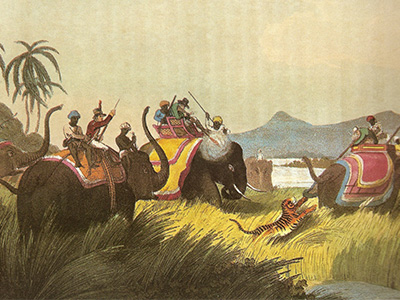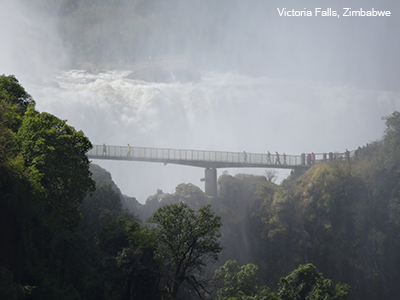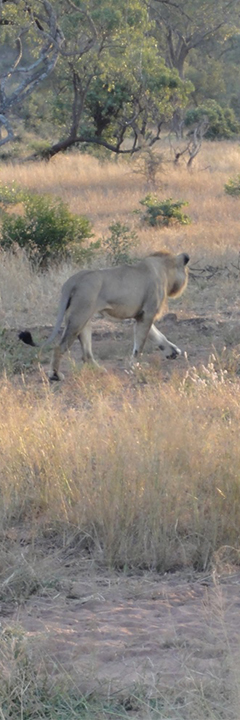Adventures & Conservation
Hello! Join me as I explore the southern countries of Africa, work with anti-poaching groups, and see what it takes to be a ranger. All while learning about how poaching -- the illegal hunting and brutal killing of endangered animals -- affects the people and economies of these regions. I'll also be exploring the vast national parks, wildlife reserves, and private game reserves to learn about elusive African wildlife and lend a hand to existing conservation efforts. And I'll be working with both foreign and local anti-poaching rangers and other volunteers in day-to-day activities that will exemplify the ranger's routine and highlight their selfless valor.

Micro Updates
29 September, 2017: A new round of posts is coming starting now! New wildlife encounters, essays on wildlife and conseravtion, and videos will be coming on a twice-monthly schedule. Thanks for staying tuned!
31 May, 2017: A new Wildlife Encounter video is up, this one taking place in Somkhanda Game Reserve, in KwaZulu-Natal, South Africa. Read the article and watch the video here!
15 April, 2017: It's been far too long since I've updated the site due to focusing on PoachingFacts.com. However I'm back from more adventures in America and Africa and will have some new content uploaded soon.
28 Feb, 2017: The latest data on rhino poaching in South Africa has been released. South Africa's Department of Environmental Affairs indicates 1,054 rhino were poached throughout 2016. Another slight decline, however poaching in the flagship Kruger National Park has only decreased to 662, from 826 the previous year.
21 Jan, 2016: The latest data on rhino poaching in South Africa has been released. The official statistics state that 1,175 rhino were illegally killed throughout 2015. Similar to last year, 826 rhino were killed in Kruger National Park. Although this marks the first year of decline in overall rhino poaching in the country since 2007, it is only a decrease of 37 since 2014. The year 2007 saw only 13 rhino killed throughout the country.
07 November, 2015: We've added some links to our sister site PoachingFacts.com as well as a new section shows recent books and reviews on wildlife, wildlife conservation, memoirs, and history relevant to Africa's current political and economic struggles. We'll have some new content coming very soon.
20 February, 2015: Things are going to slow down a little bit as we come out of winter and renew our focus on adventures and conservation. Blog posts will come roughly twice a month as we focus on opening our sister-site PoachingFacts.com. This new website aims to put factual information, environmental reports, and current and historical poaching statistics at your fingertips so that individuals can gain an unbiased view of global poaching. The site will prominently feature accurate poaching data, examples of real poachers, and information on what different countries are doing to counter wildlife crimes and trafficking.
23 January, 2015: A quiet new year for Red Hawk Adventures, but an important time for the world's conservation efforts. The end of the year brings the end of the major fundraising drives by wildlife, humanitarian, and other conservation groups working around the globe. On a related note South African National Parks (SAN Parks) has released the final data on elephant and rhino poaching for 2014. In that one year period 1,215 rhino and 2 elephants were poached with 386 arrests made, up from 2013's numbers of 1,004 rhino killed and 343 arrests of suspected poachers.
20 November, 2014: An article was recently released summarizing a study by Duke University, collaborating with Wildlife Conservation Society and Centre for Wildlife Studies, about the positive effects of volunteers and "citizen scientists" who are making impacts in wildlife and habitat conservation around the world. These programs that pair citizens and experts are increasingly fundamental in the relationship between people and the environment that they rely on. The summary is linked here and worth reading.

07 November, 2014: We just added an exciting micro-adventure to the newly opened North America section of the blog and have some other interesting articles planned for the new future. Over the past few weeks we've added a lot more articles on wildlife species that are poached in Asia, Africa, and the Americas. We'll always be adding new wildlife articles, but through the end of 2014 and beginning of the new year we'll focus on adding more equipment reviews on essential and every day carry type items.
29 September, 2014: We've updated several pages with links to featured articles, including more links to wildlife safaris. The blog has its links updated to better feature conservation and humanitarian programs that you can get invovled in. There are also a lot of new wildlife articles this month here on RHA providing some interesting information about species you've heard of and some you might not know exist!
29 August, 2014: The first video safari taking place in Africa, 'Cheetah Walk at Wild Horizons,' is now online and viewable at the Video Archive section or directly on YouTube. The virtual walk is about 90 minutes long, but chapters are setup to easily jump to the best scenery and wildlife talk from the conservation staff at Wild Horizons.
03 August, 2014: Added some more great charitable organizations to the Conservation Groups page. Specifically of note is the addition of the Thin Green Line Foundation, a front-line arm of the International Ranger Federation (highlighted in the National Parks & Related Projects section), and the African Wildlife Foundation. Both foundations offer incredibly important services to protect our wildlife, the rangers on the front lines, and the people that live in close proximity to wildlife.
23 June, 2014: Released my notes on human and wildlife tracking. Currently I'm working on archiving the wildlife video that I took while in Botswana and Zimbabwe. My goal is to begin releasing informative videos later this summer on wildlife species in an educational format that presents the wildlife going about their natural, daily routine.

May, 2014: Traveled to Botswana and Zimbabwe for more than 5 weeks. I spent several weeks volunteering in Zimbabwe with an anti-poaching group and had a great experience adding to my knowledge of African wildlife and improved my skills operating in the bush. I'll be adding more about my experiences to the Red Hawk Adventures blog.
25 April, 2014: I've added a lot of new recommendations to the Back Country Gear page, including cameras, electronics, solar charging equipment, and utilities suitable for first-time and experienced adventurers. I've also updated the Equipment Reviews section of the main site with content I've already posted or am scheduled to post on the blog.
01 April, 2014: Along with some upcoming reviews of Belleville and Tactical Research boots I am announcing a new section of the website called "Back Country Gear" which features items that will be useful to casual hikers, weekend warriors, and extreme adventurers alike. The Back Country Gear pages feature recommended or approved equipment and items that have been identified and hand selected by Red Hawk Adventures as meeting or exceeding the qualities necessary to function in extreme situations. In a single convenient location fellow adventurers will have access to a wide selection of products powered by Amazon.com (US), featured reviews, and the safety and security of Amazon's payment system and market. The Back Country Gear pages will be unobtrusive and will potentially earn revenue for Red Hawk Adventures through advertising fees paid by Amazon, but only from visitors who choose to support Red Hawk Adventures by acquiring Amazon products through the Back Country Gear page.
17 March, 2014: The latest statistics of rhino poached in South Africa have been released by the South Africa National Park service (SANParks.org) and indicate that 172 rhino have been killed since the beginning of 2014 and 54 suspected poachers arrested.
Late 2013: Processing photo and video footage for archival purposes. Digitizing a written journal of my experiences in Africa and redacting parts that would endanger the security of those I worked with. Eventually I'll publish some of these entries to show what daily life is like.
Mid 2013: Returned from Africa where I spent several weeks with an anti-poaching organization. I had the opportunity to work alongside a number of other volunteers in patrolling private reserves for intrusion attempts, tracking animals, mapping private reserves, and backing up anti-poaching rangers during multi-day excursions. I also had the chance to tour parts of the massive Kruger National Park that spans parts of four countries.
Upcoming Objectives
In the short-term I'm planning on opening up an "Adventures in America" section of the RHA Blog dedicated to some of the fantastic hiking, camping, and scenic National Parks in the American Southwest. The focus will be on the environment and activities in these areas with an emphasis on hiking and exploration along with a basic discussion on techniques related to enjoying the outdoors and surviving in the wilderness.
With more experiences gained from a second trip to Africa volunteering with an anti-poaching organization I'll be updating the "Adventures in Africa" section with more information about wildlife crimes, anti-poaching, and related topics. However I'll keep details to a minimum in order to retain operational security in medium- and high-risk poaching areas for the rangers and conservationists that work every day defending our wildlife.
What is Anti-Poaching?
Poaching is the unlawful act of killing an animal. However the repercussions of poaching extend beyond the loss of an animal's life and effect the ecosystem which is supported by that animal species, the people whose way of life may depend on that species, as well as the danger of having rogue gunman loose in a peaceful and economically prosperous country such as South Africa which is the 33rd largest economy in the world. Anti-poaching efforts work towards removing threats to humans and wildlife and putting an end to needless destruction of animals through active, armed protection; sweeping for snares and traps; animal tracking and conservation; and endorsing legislation to make it harder for poachers to profit from the butchering of animals.
In many cases poaching in Africa targets elephants for their ivory tusks, rhinoceros for their horn, and leopards for their beautiful skins. These animals are illegally killed all across Africa, on private reserves and in public National Parks, and their resources sold on the black market to distant countries. The animals' bodies are left to rot in the fields. The money made from these animals doesn't go to the public which pays for the parks, nor does it go to the private game reserves which serve tourists and private investors alike. Much of the money goes to criminal syndicates and warlords only interested in destabilizing regions and entire governments and acquiring as much power for themselves as they can at the expense of the developed world. These criminal syndicates then sell their ivory and rhino horn to Asian criminal syndicates for even greater profits where the ivory is eventually sold to wealthy, highly connected individuals and where rhino horn is used in traditional medicines.
The sale of ivory is banned in many western countries, but demand from Asia for animal parts remain a primary motivating factor in poaching in Africa, India, and the South Pacific. And this poaching is responsible for what will be the inevitable extinction of rhinoceros in just a few years. Ivory tusks are seen as a status symbol by many people, including westerners. However demand for ivory by a growing upper-middle class in Asia is straining the economies of other nations and damaging ecosystems that many Asians may not be aware exist. Poaching also directly puts human lives in danger as poachers become increasingly violent in their bid to kill as many rhino as possible.
The death of elephants and rhino, the largest species of land animals in existence on the planet, is unwarranted yet increasing yearly. Their ivory is a status symbol only for the ignorant and uninformed, though it becomes rarer with every elephant killed. Rhino horn is useless as a medicine or stimulant. It is made out of keratin, the same protein that human fingernails and hair is made from. Keratin also makes up the beaks and feathers of birds. Keratin has virtually no nutritional value and certainly no medicinal value in curing bad luck or restoring a person's spiritual energy.
Learn & Support
To learn more about the importance of conservation as a method to protect the world’s wildlife and improve standards of living for humans please visit the Objectives page. If you're ready to make a commitment to preserving our wildlife please take a look at the Conservation Organizations & Wildlife Rehabilitation Centers featured on the Conservation Groups page for organizations you can support. If you're ready to get involved in your own adventure then jump over to the Get Involved page.





